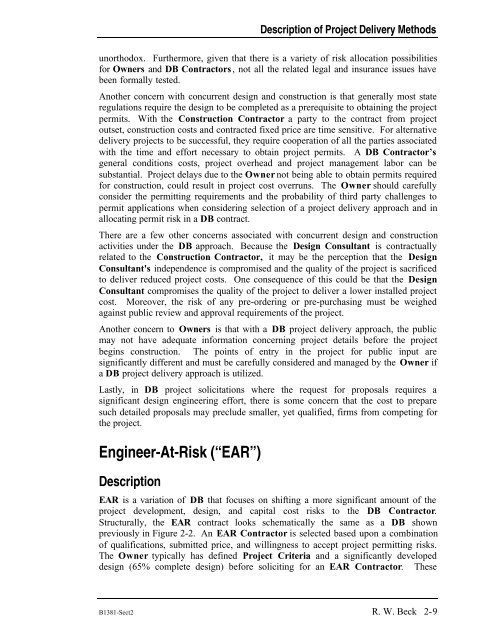Alternative Project Delivery - Texas Water Development Board
Alternative Project Delivery - Texas Water Development Board
Alternative Project Delivery - Texas Water Development Board
Create successful ePaper yourself
Turn your PDF publications into a flip-book with our unique Google optimized e-Paper software.
Description of <strong>Project</strong> <strong>Delivery</strong> Methods<br />
unorthodox. Furthermore, given that there is a variety of risk allocation possibilities<br />
for Owners and DB Contractors, not all the related legal and insurance issues have<br />
been formally tested.<br />
Another concern with concurrent design and construction is that generally most state<br />
regulations require the design to be completed as a prerequisite to obtaining the project<br />
permits. With the Construction Contractor a party to the contract from project<br />
outset, construction costs and contracted fixed price are time sensitive. For alternative<br />
delivery projects to be successful, they require cooperation of all the parties associated<br />
with the time and effort necessary to obtain project permits. A DB Contractor’s<br />
general conditions costs, project overhead and project management labor can be<br />
substantial. <strong>Project</strong> delays due to the Owner not being able to obtain permits required<br />
for construction, could result in project cost overruns. The Owner should carefully<br />
consider the permitting requirements and the probability of third party challenges to<br />
permit applications when considering selection of a project delivery approach and in<br />
allocating permit risk in a DB contract.<br />
There are a few other concerns associated with concurrent design and construction<br />
activities under the DB approach. Because the Design Consultant is contractually<br />
related to the Construction Contractor, it may be the perception that the Design<br />
Consultant's independence is compromised and the quality of the project is sacrificed<br />
to deliver reduced project costs. One consequence of this could be that the Design<br />
Consultant compromises the quality of the project to deliver a lower installed project<br />
cost. Moreover, the risk of any pre-ordering or pre-purchasing must be weighed<br />
against public review and approval requirements of the project.<br />
Another concern to Owners is that with a DB project delivery approach, the public<br />
may not have adequate information concerning project details before the project<br />
begins construction. The points of entry in the project for public input are<br />
significantly different and must be carefully considered and managed by the Owner if<br />
a DB project delivery approach is utilized.<br />
Lastly, in DB project solicitations where the request for proposals requires a<br />
significant design engineering effort, there is some concern that the cost to prepare<br />
such detailed proposals may preclude smaller, yet qualified, firms from competing for<br />
the project.<br />
Engineer-At-Risk (“EAR”)<br />
Description<br />
EAR is a variation of DB that focuses on shifting a more significant amount of the<br />
project development, design, and capital cost risks to the DB Contractor.<br />
Structurally, the EAR contract looks schematically the same as a DB shown<br />
previously in Figure 2-2. An EAR Contractor is selected based upon a combination<br />
of qualifications, submitted price, and willingness to accept project permitting risks.<br />
The Owner typically has defined <strong>Project</strong> Criteria and a significantly developed<br />
design (65% complete design) before soliciting for an EAR Contractor. These<br />
B1381-Sect2 R. W. Beck 2-9
















